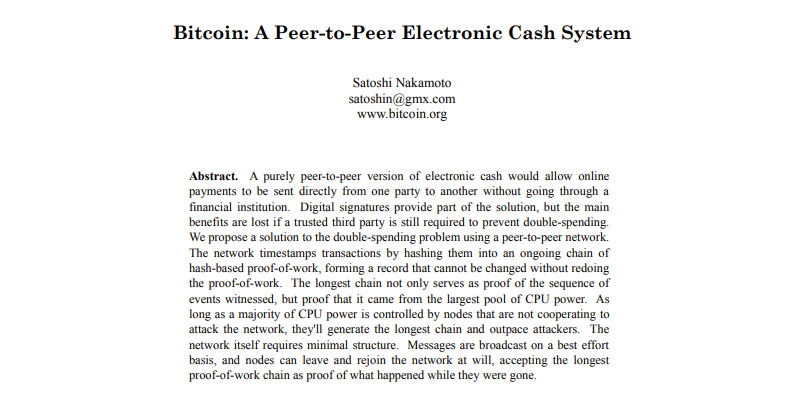Fifteen years ago today, Satoshi Nakamoto published the famous Bitcoin Protocol whitepaper for the first time. With it, the pseudonymous founder created the foundation for today's crypto industry with over a trillion US dollars in market value after the 2008 financial crisis.
Nakamoto, whose identity remains unknown to date, first announced the Bitcoin whitepaper on the "metzdowd" cryptography mailing list on October 31, 2008. He had invented a new electronic cash system based entirely on the peer-to-peer (P2P) principle and requiring no trusted third party. He published the nine-page Bitcoin whitepaper itself on bitcoin.org. Today, the famous document celebrates its 15th anniversary.

Satoshi Nakamoto finds solution to double spending problem
The pseudonymous Bitcoin founder argued in his white paper that a peer-to-peer version of electronic cash would reduce dependence on financial institutions for online payments. Finally, the publication of the whitepaper a few weeks after the collapse of Lehman Brothers was no coincidence. Previous attempts such as eCash and Hashcash had already been made in the years before, but they always failed due to the so-called "double spending problem." This is a point of attack in digital cash systems where one party can spend the same digital token more than once. In traditional financial structures, double spending is prevented by centralized controls.
Using a unique combination of cryptographic functions (hashing) and a distributed ledger, Nakamoto described the first decentralized solution to the problem in his Bitcoin white paper. The stringing together of blocks of transactions ("blockchain") would create a unique history that could only be changed with a majority of the network's computing power. Just two months later, on January 3, 2009, the first Bitcoin block was mined based on the protocol described in the white paper.
"Blockchain technology fascinated me several years before the Bitcoin whitepaper was published. I originally looked at the topic from an IT perspective and only later from a finance perspective. [...] I found the nine-page document groundbreaking for the time, especially against the backdrop of the financial crisis in 2008. The whitepaper laid the foundation for an entire industry and created new asset classes." - Franz Bergmüller, CEO of SEBA Bank
Bitcoin whitepaper as basis for trillion dollar industry
Ultimately, Nakamoto's groundbreaking white paper provided the blueprint for creating a trusted and decentralized financial system. The document continued to inspire countless developers and entrepreneurs to build on these principles for years to come. As a result, the pseudonymous founder can now look back on a billion-dollar industry with thousands of different projects. For despite the sometimes bad reputation of the blockchain industry, Nakomoto would be proud of today's ecosystem, says Rune Christensen, founder of the DeFi protocol MakerDAO, in an interview with CVJ.CH.
"The Bitcoin whitepaper is the foundation of blockchain technology. But for me, it's not just about the technology, it's also about the idea that we can create a better financial system. DeFi builds on the transparent and decentralized elements of Bitcoin to create an ecosystem that gives people more control over their finances. [Nakamoto] would find that incredibly cool, no doubt." - Rune Christensen, founder of MakerDAO
Christensen admits that a complete financial revolution in the sense of the original "cypherpunks" has not come about. Nevertheless, decentralized finance has undoubtedly had an impact on people around the world, despite the still great untapped potential.




